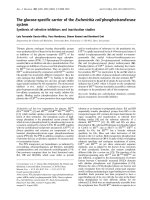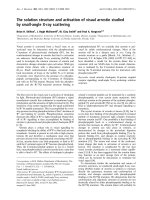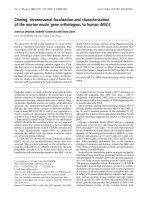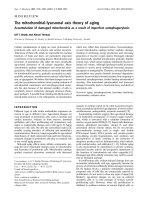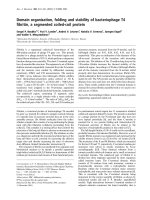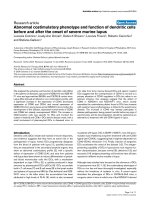Báo cáo y học: "The draft genome and transcriptome of Cannabis sativa" pot
Bạn đang xem bản rút gọn của tài liệu. Xem và tải ngay bản đầy đủ của tài liệu tại đây (888.16 KB, 57 trang )
This Provisional PDF corresponds to the article as it appeared upon acceptance. Copyedited and
fully formatted PDF and full text (HTML) versions will be made available soon.
The draft genome and transcriptome of Cannabis sativa
Genome Biology 2011, 12:R102 doi:10.1186/gb-2011-12-10-r102
Harm van Bakel ()
Jake M Stout ()
Atina G Cote ()
Carling M Tallon ()
Andrew G Sharpe ()
Timothy R Hughes ()
Jonathan E Page ()
ISSN 1465-6906
Article type Research
Submission date 11 September 2011
Acceptance date 20 October 2011
Publication date 20 October 2011
Article URL />This peer-reviewed article was published immediately upon acceptance. It can be downloaded,
printed and distributed freely for any purposes (see copyright notice below).
Articles in Genome Biology are listed in PubMed and archived at PubMed Central.
For information about publishing your research in Genome Biology go to
/>Genome Biology
© 2011 van Bakel et al. ; licensee BioMed Central Ltd.
This is an open access article distributed under the terms of the Creative Commons Attribution License ( />which permits unrestricted use, distribution, and reproduction in any medium, provided the original work is properly cited.
1
The draft genome and transcriptome of Cannabis sativa
Harm van Bakel
1
, Jake M Stout
2,4
, Atina G Cote
1
, Carling M Tallon
2
, Andrew G Sharpe
2
,
Timothy R Hughes
1,3*
and Jonathan E Page
2,4*
1
Banting and Best Department of Medical Research and Terrence Donnelly Centre for
Cellular and Biomolecular Research, University of Toronto, 160 College St. Room 230,
Toronto, ON, M5S 3E1, Canada
2
National Research Council of Canada, Plant Biotechnology Institute, 110 Gymnasium
Place, Saskatoon, SK, S7N 0W9, Canada
3
Department of Molecular Genetics, University of Toronto, #4396 Medical Sciences
Building, 1 King’s College Circle, Toronto, ON, M5S 1A8 Canada
4
Department of Biology, University of Saskatchewan, 112 Science Place, Saskatoon,
SK, S7N 5E2 Canada
*Correspondence: ,
2
Abstract
Background
Cannabis sativa has been cultivated throughout human history as a source of fiber, oil and food, and for
its medicinal and intoxicating properties. Selective breeding has produced cannabis plants for specific
uses, including high-potency marijuana strains and hemp cultivars for fiber and seed production. The
molecular biology underlying cannabinoid biosynthesis and other traits of interest is largely unexplored.
Results
We sequenced genomic DNA and RNA from the marijuana strain Purple Kush using shortread
approaches. We report a draft haploid genome sequence of 534 Mb and a transcriptome of 30,000
genes. Comparison of the transcriptome of Purple Kush with that of the hemp cultivar ‘Finola’ revealed
that many genes encoding proteins involved in cannabinoid and precursor pathways are more highly
expressed in Purple Kush than in ‘Finola’. The exclusive occurrence of ∆
9
-tetrahydrocannabinolic acid
synthase in the Purple Kush transcriptome, and its replacement by cannabidiolic acid synthase in ‘Finola’,
may explain why the psychoactive cannabinoid ∆
9
-tetrahydrocannabinol (THC) is produced in marijuana
but not in hemp. Resequencing the hemp cultivars ‘Finola’ and ‘USO-31' showed little difference in gene
copy numbers of cannabinoid pathway enzymes. However, single nucleotide variant analysis uncovered
a relatively high level of variation among four cannabis types, and supported a separation of marijuana
and hemp.
Conclusions
The availability of the Cannabis sativa genome enables the study of a multifunctional plant that occupies
a unique role in human culture. Its availability will aid the development of therapeutic marijuana strains
with tailored cannabinoid profiles and provide a basis for the breeding of hemp with improved agronomic
characteristics.
Keywords
3
Cannabaceae, cannabis, marijuana, hemp, genome, transcriptome, cannabinoid.
4
Background
One of the earliest domesticated plant species, Cannabis sativa L. (marijuana, hemp;
Cannabaceae) has been used for millennia as a source of fibre, oil- and protein-rich
achenes (“seeds”) and for its medicinal and psychoactive properties. From its site of
domestication in Central Asia, the cultivation of cannabis spread in ancient times
throughout Asia and Europe and is now one of the most widely distributed cultivated
plants [1]. Hemp fibre was used for textile production in China more than 6000 years BP
(before present) [2]. Archaeological evidence for the medicinal or shamanistic use of
cannabis has been found in a 2700-year old tomb in north-western China and a Judean
tomb from 1700 years BP [3,4]. Currently cannabis and its derivatives such as hashish
are the most widely consumed illicit drugs in the world [5]. Its use is also increasingly
recognized in the treatment of a range of diseases such as multiple sclerosis and
conditions with chronic pain [6,7]. In addition, hemp forms of cannabis are grown as an
agricultural crop in many countries.
Cannabis is an erect annual herb with a dioecious breeding system, although
monoecious plants exist. Wild and cultivated forms of cannabis are morphologically
variable, resulting in confusion and controversy over the taxonomic organization of the
genus (see [8] for review). Some authors have proposed a monotypic genus, C. sativa,
while others have argued that Cannabis is composed of two species, Cannabis sativa
and Cannabis indica, and some have included a third species, Cannabis ruderalis, in
5
the genus. In light of the taxonomic uncertainty, we use C. sativa to describe the plants
analyzed in this study.
The unique pharmacological properties of cannabis are due to the presence of
cannabinoids, a group of more than 100 natural products that mainly accumulate in
female flowers (“buds”) [9,10]. ∆
9
-Tetrahydrocannabinol (THC) is the principle
psychoactive cannabinoid and the compound responsible for the analgesic, antiemetic
and appetite-stimulating effects of cannabis [11,12]. Non-psychoactive cannabinoids
such as cannabidiol (CBD), cannabichromene (CBC) and ∆
9
-tetrahydrocannabivarin
(THCV), which possess diverse pharmacological activities, are also present in some
varieties or strains [13-15]. Cannabinoids are synthesized as carboxylic acids and upon
heating or smoking decarboxylate to their neutral forms; for example, ∆
9
-
tetrahydrocannabinolic acid (THCA) is converted to THC. Although cannabinoid
biosynthesis is not understood at the biochemical or genetic level, several key enzymes
have been identified including a candidate polyketide synthase and the two
oxidocyclases, THCA synthase (THCAS) and cannabidiolic acid (CBDA) synthase,
which form the major cannabinoid acids [16-18].
Cannabinoid content and composition is highly variable among cannabis plants. Those
with a high-THCA/low-CBDA chemotype are termed marijuana, whereas those with a
low-THCA/high-CBDA chemotype are termed hemp. There are large differences in the
minor cannabinoid constituents within these basic chemotypes. Breeding of cannabis
for use as a drug and medicine, as well as improved cultivation practices, has led to
6
increased potency in the past several decades with median levels of THC in dried
female flowers of ca. 11% by dry weight; levels in some plants exceed 23% [10,19].
This breeding effort, largely a covert activity by marijuana growers, has produced
hundreds of strains that differ in cannabinoid and terpenoid composition, as well as
appearance and growth characteristics. Patients report medical marijuana strains differ
in their therapeutic effects, although evidence for this is anecdotal.
Cannabis has a diploid genome (2n = 20) with a karyotype composed of nine
autosomes and a pair of sex chromosomes (X and Y). Female plants are homogametic
(XX) and males heterogametic (XY) with sex determination controlled by an X-to-
autosome balance system [20]. The estimated size of the haploid genome is 818 Mb for
female plants and 843 Mb for male plants, owing to the larger size of the Y chromosome
[21]. The genomic resources available for cannabis are mainly confined to
transcriptome information: NCBI contains 12,907 ESTs and 23 unassembled RNA-Seq
datasets of Illumina reads [22,23]. Neither a physical nor a genetic map of the cannabis
genome is available.
Here, we report a draft genome and transcriptome sequence of C. sativa Purple Kush
(PK), a marijuana strain that is widely used for its medicinal effects [24]. We compared
the genome of PK with that of the hemp cultivars ‘Finola’ and ‘USO-31’, and the
transcriptome of PK flowers with that of ‘Finola’ flowers. We found evidence for the
selection of cannabis for medicinal and drug (marijuana) use in the up-regulation of
7
cannabinoid ‘pathway genes’ and the exclusive presence of functional THCA synthase
(THCAS) in the genome and transcriptome of PK.
Results
Sequencing the C. sativa PK genome and transcriptome {2nd level subheading}
We obtained DNA and RNA samples from plants of PK, a clonally propagated
marijuana strain that may have been bred in California and is reportedly derived from an
“indica” genetic background [24]. Genomic DNA was isolated from PK leaves and used
to create six 2 ×100-bp Illumina paired-end libraries with median insert sizes of
approximately 200, 300, 350, 580 and 660 bp. Sequencing each of these libraries
produced >92 gigabase (Gb) of data after filtering of low-quality reads (see below),
which is equivalent to approximately 110× coverage of the estimated ~820 Mb genome.
To improve repeat resolution and scaffolding, we supplemented these data with four 2 ×
44-bp Illumina mate-pair libraries with a median insert size of approximately 1.8 kb and
two 2 × 44-bp libraries with a median insert size of approximately 4.6 kb, adding 16.3
Gb of sequencing data in 185 million unique mated reads. We also included eleven 454
mate-pair libraries with insert sizes ranging from 8 to 40 kb, obtaining >1.9 Gb of raw
sequence data (~2.3 × coverage of 820 Mb) and 2 M unique mated reads.
To characterize the cannabis transcriptome, we sequenced polyA+ RNA from a panel of
six PK tissues (roots, stems, vegetative shoots, pre-flowers (i.e. primordia) and flowers
(in early- and mid-stages of development)) obtaining >18.8 Gb of sequence. To
8
increase coverage of rare transcripts, we also sequenced a normalized cDNA library
made from a mixture of the six RNA samples, obtaining an additional 33.9 Gb. The
sequencing data obtained for the genomic and RNA-Seq libraries are summarized in
Table 1.
Assembling the C. sativa PK genome and transcriptome
We used different approaches for the de novo assembly of the PK genome
(SOAPdenovo [25]) and transcriptome (ABySS [26] and Inchworm [27]). To gauge the
success of the outputs, and to refine the assemblies, we used both traditional measures
(coverage, bases in assembly, N50, maximum contig size and contig count) as well as
comparisons between the assembled versions of the genome and transcriptome.
For the transcriptome, we used two different assemblers, ABySS and Inchworm, to
obtain the best possible coverage. Both assemblers were run on the individual tissue
datasets and normalized cDNA libraries, as well as the full set of RNA-Seq data
(summarized in Table 2). We used predicted splice junctions and the presence of
apparent coding regions to orient the assembled transcripts and to perform quality
control (QC). In general, Inchworm produced assemblies with a larger N50 than ABySS
(Table 2); however, we also observed many cases in which adjacent transcripts (e.g.
head-to-head transcripts that overlap in their termini) appeared to be merged.
Therefore, we considered only Inchworm transcripts with a single blastx hit covering at
least 70% of their length when merging assemblies. The filtered individual ABySS and
Inchworm assemblies were combined by first selecting the largest transcript among sets
9
of near-identical sequences from each assembly, followed by a second stage where
transcripts with blunt overlaps were joined. This second step resulted in a significant
improvement of transcript N50 from 1.65 to 1.80 kb (Table 2).
The final merged assembly contains 40,224 transcripts falling into 30,074 clusters of
isoforms (Table 3). We selected the transcript with the largest open reading frame
(ORF) as the representative for each cluster, resulting in a pruned assembly with an
N50 of 1.91 kb. Most representative transcripts (83%) have a blastx hit in other plants,
and the distribution of transcript classes, according to Panther [28], is nearly identical
between PK and Arabidopsis (Figure 1), as is the total number of transcripts and the
N50 (33,602 and 1.93 kb in Arabidopsis, respectively [29]). The total number of bases in
representative Arabidopsis transcripts is, however, somewhat larger (50 Mb, [29]) which
may indicate that some of the PK transcripts are partial or that genes are represented
by more than one non-contiguous fragments. We noted a 3’ end bias in the normalized
cDNA library, presumably due to the polyA priming step (data not shown). Moreover, by
combining near-identical transcripts during assembly merging and isoform clustering,
we likely collapsed transcripts of large multi-copy gene families. Indeed, applying our
isoform clustering algorithm to the Arabidopsis assembly reduces the total number of
bases to 44 Mb, which is mostly due to the loss of transposable element genes. Overall,
our assembled PK transcriptome is therefore very similar to the deeply characterized
Arabidopsis transcriptome, both in size and composition.
10
Our genome assembly procedure first involved a series of filtering steps to remove low-
quality reads, bacterial sequences (about 2% of all reads) and sequencing adapters.
Mate-pair libraries (454 and Illumina) were further processed to remove duplicate pairs
and unmated reads. We then assembled a small fraction of the Illumina data (1%)
together with the 454 data, to reconstruct the mitochondrial (approximately 450 kb) and
plastid (approximately 150 kb) genomes, and subsequently removed their highly
abundant DNA sequences. The remaining reads were assembled with SOAPdenovo,
resulting in a draft assembly that spans >786 Mb of the cannabis genome and includes
534 million bp (Table 3). The Illumina mate-pair libraries had a significant impact on the
assembly, increasing the N50 from 2 kb to 12 kb. Addition of the large-insert 454 data
increased this to 16 kb (24.9 kb for scaffolds containing genes). Between 73% and 87%
of the reads in each library could be mapped back to the draft genome (Table 1),
indicating that our assembly accounts for most of the bases sequenced. As an
additional measure of completeness, we also examined the proportion of the
transcriptome represented in the genome assembly. Over 94% of assembled transcripts
map to the draft genome over at least half of their length, and 83.9% of them are fully
represented; that is, all bases of the transcript can be mapped to genomic contigs.
Overall, 37.6 Mb (92.5%) of the complete transcriptome is accounted for in the genome
assembly (Figure 2), and over 68.9% of transcripts are fully encompassed by a single
scaffold. Thus, our draft genome assembly appears to represent a large majority of the
genic, non-repetitive C. sativa genome.
11
The assembled C. sativa PK genome and transcriptome (canSat3) can be downloaded
and browsed at a dedicated website [30]. The Cannabis Genome Browser combines the
genome assembly with the transcriptome annotations, and has tracks for RNA-Seq
data, single nucleotide variants (SNVs) and repeats.
Expression of the cannabinoid pathway in C. sativa PK tissues
Our first step in the functional analysis of the C. sativa genome was to examine the
relative expression of each of the 30,074 representative transcripts in the six PK
tissues, from which the RNA-Seq data were derived (Figure 3a). In metazoans (e.g.
humans), different organs and tissues have different physiological functions, and
consequently have unique gene expression profiles [31]. Therefore, many genes have a
highly restricted expression pattern. By contrast, in plants, different photosynthetic
tissues are often composed of a similar set of cell types. Moreover, photosynthetic
processes and primary metabolic pathways have widespread expression, and only a
minor proportion of transcripts appear to be uniquely expressed in a given cell type [32].
Consistent with these observations, we found all of the cannabis photosynthetic tissues
to have similar expression profiles (Figure 3a).
Nonetheless, flowers show a pattern of gene expression consistent with the
biosynthesis of cannabinoids and terpenoids in these organs. Cannabinoids are
prenylated polyketides that are synthesized from the short-chain fatty acid hexanoate
and geranyl diphosphate (GPP) [23,33]. The latter precursor, which is the substrate for
an aromatic prenyltransferase enzyme, is derived from the 2-C-methyl-D-erythritol 4-
12
phosphate (MEP) pathway [34,35,36] (see Figure 3b for details). We found that the
genes encoding cannabinoid pathway enzymes and also most of those encoding
proteins (e.g. hexanoate, MEP and GPP) involved in putative precursor pathways were
most highly expressed in the three stages of flower development (pre-flowers, and
flowers in early and mid-stage of development) (Figure 3c). This finding is consistent
with cannabinoids being synthesized in glandular trichomes, the highest density of
which is found on female flowers [37]. The production of THCA in marijuana strains
(such as PK) and CBDA in hemp, is due to the presence or absence of THCAS and
CBDA synthase (CBDAS) in these two chemotypes. Indeed, THCAS is highly
expressed in PK flowers of all stages, whereas CBDAS is absent (Figure 3c).
It is worth noting that of the 19 ‘pathway genes’ we analyzed, 18 were complete in the
transcriptome assembly, underscoring its quality. The transcript of the MDS gene (which
encodes a protein involved in the MEP pathway) was assembled in two fragments with
a blunt overlap of 48 nt, narrowly missing the merging threshold of 50 nt. This sequence
was resolved by merging the fragments manually. All ‘pathway genes’ are fully
represented in the draft genome and an overview of their genomic locations is provided
on the Cannabis Genome Browser website [30].
Comparison of the expression of cannabinoid pathway genes between marijuana (PK)
and hemp (‘Finola’)
Although there are differences in the morphology of marijuana and hemp strains, the
THC content of PK and other strains selected and bred for use as marijuana is
13
remarkably high. We investigated whether the high THC production in PK was
associated with increased gene expression levels of cannabinoid pathway enzymes,
relative to those in hemp. We performed RNA-Seq analysis on Finola flowers at the
mid-stage of development, generating a total of 18.2 M reads. ‘Finola’ is a short,
dioecious, autoflowering cultivar developed in Finland for oil seed production. It was
created by crossing early maturing hemp varieties from the Vavilov Research Institute
(St. Petersburg, Russia), ‘Finola’ might be derived from a “ruderalis” genetic background
[38]. It contains moderate amounts of CBDA in female flowers but very low amounts
(<0.3% by dry weight) of THCA. Figure 4a shows that the overall mid-flower transcript
profiles, expressed as RPKM (reads per kb per million reads), are similar between PK
and ‘Finola’; however, the entire cannabinoid pathway is expressed at higher levels in
PK than in ‘Finola’, with later steps increased as much as 15-fold (Figure 4a).
The difference in gene expression is not due to morphological variability between the
strains, such as in the size or proportion of trichomes. We examined the global
expression levels of trichome genes to account for possible differences in trichome
density between PK and ‘Finola’ flowers, by analyzing an RNA-Seq dataset obtained for
‘Finola’ glandular trichomes (from a separate study, data not shown). From a set of
the1000 most abundant transcripts, we selected 100 that had the greatest difference in
expression between the mid-flower stage and the maximum expression level found in
PK root, shoot or stem in the current study. This subset of genes should be highly
enriched for genes predominantly expressed in glandular trichomes (and indeed
contained all the cannabinoid and hexanoate ‘pathway genes’ expressed in ‘Finola’).
14
The median difference in expression level after excluding the cannabinoid genes is
shown as a dotted line in Figure 4a, and was used to adjust the expression differences
shown in Figure 4c. Even after accounting for global trichome differences, cannabinoid
pathway enzymes remain among several hundred obvious outliers. Outliers also include
several dozen transcription factors, including two Myb-domain proteins that have been
previously suggested to play a role in regulating processes in cannabis trichomes [23]
(Figure 4a). These data suggest that the increased production of cannabinoids in PK
may be due in part to an increase in expression of the biosynthetic genes.
Resequencing of the C. sativa ‘Finola’ genome reveals copy number changes in a PK
cannabinoid pathway related enzyme
To begin our search for the underlying causes of the differences between marijuana and
hemp, we sequenced the genome of ‘Finola’ (e.g. Illumina 100 nt paired-end reads,
200-500 bp inserts, at approximately 50× coverage of the estimated 820 Mb genome).
Plant genomes often contain many duplicated genes, and gene amplification represents
a well-documented mechanism for increasing expression levels [39]. Therefore, we first
asked whether there were apparent differences in copy number for the enzyme-
encoding gene set, using the median read depth (MRD) of genomic DNA-Seq reads
that could be uniquely mapped to transcripts as a proxy. Figure 4b illustrates that,
overall, there appear to be relatively few differences in gene MRD between PK and
‘Finola’. The exception to this is the much expanded coverage for AAE3, a gene
encoding an enzyme of unknown function in PK. AAE3 is similar to an Arabidopsis AAE
[TAIR:At4g05160] that has been shown to activate medium- and long-chain fatty acids
15
including hexanoate [40]. Although AAE1 is a more likely candidate for the hexanoyl-
CoA synthetase involved in cannabinoid biosynthesis (JMS and JEP, unpublished
results), owing to its high expression in flower tissues and increased transcript
abundance in PK (Figure 3b, Figure 4), AAE3 might play an, as yet, unknown role in
cannabinoid biosynthesis. Because we could detect both multi- and single-exon copies
of AAE3, we believe that the large expansion of AAE3 has occurred through the
insertion of processed pseudogenes in the PK genome. In addition, the read depth
analysis uncovered reads corresponding to CBDAS in PK and THCAS in ‘Finola’.
However, on the basis of our inability to assemble these into functional protein-coding
genes, we conclude that the THCAS reads in ‘Finola’ and CBDAS reads in PK are likely
to be caused by the presence of pseudogenic copies, as we discuss below. Therefore, it
appears that the differences in expression of cannabinoid pathway enzymes between
marijuana and hemp are due to subtle genetic differences that cause changes in gene
expression, either directly or indirectly.
The PK genome contains two copies of two genes involved in cannabinoid biosynthesis.
Copies of AAE1, which encodes a protein likely to synthesize the hexanoyl-CoA
precursor for cannabinoid biosynthesis, are found on scaffold1750 [genbank:JH227821]
and scaffold29030 [genbank:JH245535]. OLS, which encodes the putative cannabinoid
pathway polyketide synthase [18], was found to be duplicated at scaffold15717
[genbank:JH226441] and scaffold16618 [genbank:JH237993].
Analysis of single nucleotide variants (SNVs) in cannabis
16
To further examine the genetic variation in C. sativa, we estimated the frequency of
SNVs in four taxa. In addition to PK and ‘Finola’, our analysis included the Illumina
reads we generated from the hemp cultivar ‘USO-31’, as well as the reads from the
marijuana strain Chemdawg, which were released by Medical Genomics, LLC [41] while
this manuscript was in preparation. ‘USO-31’ is a tall, monoecious fibre hemp cultivar
developed in the former Soviet Union that contains very low or undetectable levels of
cannabinoids [42]. Our resequencing of ‘USO-31’ was similar to that of ‘Finola’ (Illumina
100 nt paired-end reads, 200 and 500 bp inserts, at approximately 16× coverage of the
estimated 820 Mb genome). We aligned individual Illumina reads to the PK reference
genome, and identified variant bases that qualify as SNVs (see the Methods section for
further details). We also quantified the degree of heterozygosity within single genomes.
Overall, PK, Chemdawg, ‘Finola’ and ‘USO-31’ have comparable rates of heterozygosity
(0.20%, 0.26%, 0.25%, and 0.18%, respectively). The lower rate of heterozygosity in
‘USO-31’, which is monoecious, is presumably due to self-pollination.
The rate of occurrence of SNVs between any two strains ranged from 0.38% (PK versus
Chemdawg) to 0.64% (Chemdawg versus ‘Finola’). A neighbor-joining tree constructed
using the concatenated polymorphic sequences from each of the strains is shown in
Figure 5, and supports the expected pedigree of the two hemp cultivars, which are likely
to have been bred using germplasm from North Central Asia. Although the ancestry of
PK and Chemdawg is unclear, their position on the tree supports the notion that
marijuana forms of cannabis are more related to each other than to the hemp forms,
and that these two marijuana strains share a common heritage.
17
Genomic analysis of cannabinoid chemotypes
The molecular basis for THCA (marijuana) and CBDA (hemp) chemotypes is unclear.
De Meijer et al [43] crossed CBDA- and THCA-dominant plants to produce F1 progeny
that are intermediate in their ratio of THCA:CBDA; selfing gave F2 progeny that
segregated 1:2:1 for THCA-dominant:codominant mixed THCA/CBDA:CBDA-dominant
chemotypes. These data suggested two explanations: a single cannabinoid synthase
locus (B) exists with different alleles of this gene encoding THCAS or CBDAS; or
THCAS and CBDAS are encoded by two tightly linked yet genetically separate loci. In
the latter scenario, differences in transcript abundance and/or enzyme efficiencies might
account for the observed chemotypic ratios. Indeed, given that both of these enzymes
compete for CBGA, reductions in one activity might lead to a proportional increase in
the production of the other cannabinoid. Our draft sequence of the THCA-dominant PK
genome enables some preliminary insights into possible mechanisms of the inheritance
of cannabinoid profiles. Using the published THCAS sequence [genbank:AB057805]
[16] to query the PK genome, a single scaffold of 12.6 kb (scaffold19603,
[genbank:JH239911]) was identified that contained the THCAS gene as a single 1638
bp exon with 99% nucleotide identity to the published THCAS sequence. Querying the
PK transcriptome returned the same THCAS transcript (PK29242.1,
[genbank:JP450547]) that was found to be expressed at high abundance in female
flowers (Figure 3c). A THCAS-like pseudogene (scaffold1330 [genbank:JH227480],
91% nucleotide identity to THCAS) was also identified. We used the CBDAS sequence
[genbank:AB292682] [17] to query the PK genome and identified as many as three
18
scaffolds that contain CBDAS pseudogenes (scaffold39155 [genbank:
AGQN01159678], 95% nucleotide identity to CBDAS; scaffold6274
[genbank:JH231038] + scaffold74778 [genbank:JH266266] combined, 94% identity; and
scaffold99205 [genbank:AGQN01254730], 94% identity), all of which contained
premature stop codons and frameshift mutations. The presence of these pseudogenes
in the PK genome accounts for the identification of CBDAS genomic sequences in PK
(Figure 4c). A 347-bp transcript fragment (PK08888.1, [genbank:JP462955]) with 100%
nucleotide identity to CBDAS could be identified in the PK transcriptome, likely due to
the nonsense-mediated decay of transcripts derived from CBDAS pseudogenes. Given
that multiple independent loci were identified with high sequence similarity to either
THCAS or CBDAS in a THCA-dominant marijuana strain, the two-loci model for the
genetic control of THCA:CBDA ratios might be correct. A possible explanation is that
during the development of high-THC marijuana strains such as PK, underground
breeders selected for non-functional CBDAS that would effectively eliminate substrate
competition for CBGA and thus increase THCA production. Alternatively, the CBDAS
pseudogene in the PK genome might occur in all cannabis strains. If this is true, the
single-locus model might still be correct, and we did not find a CBDAS-encoding allele
at this locus because PK is homozygous for THCAS.
Analysis of PK transcriptome for cannabichromenic acid synthase (CBCAS) candidates
To illustrate the potential value of the cannabis genome and transcriptome to elucidate
cannabinoid biosynthesis, we searched for genes encoding enzymes that might
catalyze the formation of cannabichromenic acid (CBCA), which is present in most
19
cannabis plants as a minor constituent and in certain strains as the dominant
cannabinoid [44]. Although a protein that synthesizes CBCA has been purified from
cannabis, the gene that encodes the CBCA synthase (CBCAS) has not been identified
[45]. We hypothesized that CBCAS is an oxidocyclase enzyme related to THCAS and
CBDAS, therefore, we queried the PK transcriptome using THCAS and CBDAS
sequences. In total, 23 candidates were identified that had greater than 65% nucleotide
identity with these sequences. These include four genes that we designated THCAS-
like1 to THCAS-like4, which encode proteins that are 89%, 64%, 68%, and 59%
identical to THCAS at the amino acid level, respectively. We also identified transcripts
corresponding to CBDAS2 and CBDAS3, which are closely related to CBDAS but do
not encode enzymes with CBDAS activity [17]. The remaining 18 transcripts encode
proteins that are similar to reticuline oxidase, an oxidoreductase that functions in
alkaloid biosynthesis [46]. Biochemical analysis of CBCAS candidates is currently
underway.
Discussion
We anticipate that the cannabis genome and transcriptome sequences will be
invaluable for understanding the unique biological properties and considerable
phenotypic variation in the genus Cannabis. These genomic resources are applicable to
the molecular analysis of both marijuana and hemp, as we sequenced a marijuana
strain (PK) and two hemp cultivars (‘Finola’ and ‘USO-31’) grown in Canada and
elsewhere. The high repeat content of plant genomes, coupled with the relatively high
level of sequence variation in cannabis [47-49], complicates the assembly of the full
20
genome into the anticipated nine autosomes and two sex chromosomes. We will
continue to explore approaches that might facilitate assembly of the full genome
sequence, including anchoring the genome using molecular markers or FISH
(fluorescence in situ hybridization) [50]. A more complete assembly might provide the
sequences of the X and Y chromosomes and help shed light on the mechanism of sex
determination in cannabis. Nonetheless, our current assembly appears to encompass
the vast majority of the non-repetitive genome and the individual genes.
Mechoulam [13] characterized the plant-derived cannabinoids as a ‘neglected
pharmacological treasure trove’ and others have noted the potentially useful biologically
activities yet to be identified for this group of plant natural products [15]. Medical
marijuana strains reportedly have different therapeutic effects based on levels of THC,
THC:CBD ratios, the presence of minor cannabinoids and the contribution of other
metabolites such as terpenoids [51]. The sequences of the cannabis genome and
transcriptome will provide opportunities for identifying the pathways and remaining
enzymes leading to the major and minor cannabinoids. Such knowledge will facilitate
breeding of cannabis for medical and pharmaceutical applications. For example,
analysis of the PK transcriptome has enabled us to identify several candidate genes
that might encode CBCAS, which forms a cannabinoid with interesting biological
activities [14,52,53]. Despite the low levels of THC in modern hemp strains, the
cannabinoid content of hemp remains a significant impediment to wider cultivation
because of regulations that require germplasm to be carefully controlled and for crops to
be tested to ensure they contain less than 0.3% THC. The genome sequence will aid
21
the development of hemp cultivars that are devoid of cannabinoids through marker-
assisted selection and other breeding techniques.
The differences in the expression of cannabinoid pathway enzymes in PK and ‘Finola’
are also of interest, and could be due to either cis- or trans-regulatory alterations. The
up-regulation of the cannabinoid pathway in PK appears to be a consequence of the
longstanding breeding effort to create marijuana strains with enhanced psychoactivity
through increased THC levels. Plant domestication is often accompanied by a reduction
of secondary metabolic pathways, many of which produce toxic or unpalatable
compounds that have defensive functions [54,55]. The opposite appears to be the case
in marijuana strains of cannabis, where there has been positive selection for THC
production. This is primarily due to two molecular events: the selection for THCAS over
CBDAS and the up-regulation of the cannabinoid pathway and pathways supplying
metabolic precursors. Our analysis indicates that amplification of cannabinoid pathway
genes does not appear to play a causative role in this increased expression. Most of the
key domestication genes in crop plants have been shown to encode transcription
factors [56]. It seems likely that one of the processes causing the emergence of high-
THC marijuana strains is also due to transcriptional alterations in cannabinoid pathway
regulation. Indeed, we find evidence for the increased expression of a multitude of
transcription factors in PK compared with those in ‘Finola’ (Figure 4a).
The underlying mechanisms for this transcriptional control could probably be dissected
using existing techniques, were there not severe legal restrictions in most jurisdictions
22
on growing cannabis, even for research purposes. Although this difficulty is somewhat
unique to cannabis, more generally it is becoming common to obtain genome
sequences and transcriptome data for organisms that are not experimentally tractable.
We propose that in silico analyses, for example, modeling of regulatory networks, can
provide a way to explore the function and evolution of such genomes. On the basis of
close homology to Arabidopsis transcription factors, it is possible to infer the sequence
specificities of many cannabis transcription factors (HvB and M Weirauch, unpublished
results). This modeling of cannabis transcriptional networks is already feasible.
Finally, the genome sequence will enable investigation of the evolutionary history, and
the molecular impact of domestication and breeding on C. sativa. The taxonomic
treatment of the genus Cannabis has been controversial. It might be feasible to use
sequence-based genotyping to trace the relationships in cannabis taxa, including wild
germplasm, landraces, cultivars and strains, as has recently been demonstrated in
grape [57,58]. Our SNV analysis has already allowed for the separation of two hemp
cultivars from two marijuana strains, suggesting additional analysis of diverse cannabis
germplasm is warranted. Outstanding areas that might be addressed by further genomic
investigation include whether the genus is composed of one or several species, the
existence of ‘sativa’ and ‘indica’ gene pools, the relative contributions that wild
ancestors have made to modern hemp and marijuana germplasm, and the process by
which cannabis was first domesticated by humans.
Conclusions
23
C. sativa has been cultivated throughout human history as a source of fibre, oil, food,
drugs and medicine. Here, we have presented a draft genome and transcriptome of C.
sativa, and compared the genomes and flower transcriptomes of high- and low-THCA
producing strains (PK (high), ‘Finola’ (low) and ‘USO-31’ (low to absent)). THCAS, the
gene encoding the oxidocyclase enzyme that forms the THC precursor THCA, is found
in the genome and transcriptome of PK, whereas CBDAS dominates in the ‘Finola’
hemp cultivar. Moreover, we find that most of the cannabinoid biosynthetic pathway
enzymes are highly expressed in flower tissues containing glandular trichomes, and that
the expression of the cannabinoid biosynthetic enzymes is elevated in the high-THCA
PK strain, even relative to other genes expressed specifically in glandular
trichomes. Although some of the genes encoding pathway enzymes are present in
multiple copies, amplifications do not appear to account for the increased expression.
The C. sativa genome sequence will greatly facilitate exploration of the molecular
biology and evolutionary history of this culturally significant and exceptionally useful
plant.
24
Materials and methods
Plant material
Frozen samples of C. sativa PK from clonally propagated female plants were obtained
from an authorized medical marijuana grower in Vancouver, BC, Canada. Plants of the
hemp cultivars C. sativa ‘Finola’ (originally called ‘FIN-314’) and C. sativa ‘USO-31’
were grown from seed in controlled environment chambers at the NRC Plant
Biotechnology Institute, Saskatoon, SK, Canada.
Nucleic acid isolation
Genomic DNA was extracted from nuclei isolated from approximately 30 g of young
leaves from PK using the method described in [59] with modifications from [60]. DNA
was isolated from a single ‘Finola’ plant and a single ‘USO-31’ plant using the same
method. For RNA-Seq analysis, total RNA was isolated from PK roots, stems, shoots
(shoot tips with young leaves and apical meristems), pre-flowers (shoot tips with flower
primordia but no visible stigmas), and early-stage flowers (flowers with visible stigmas)
and mid-stage flowers (flowers with visible, non-withered stigmas and conspicuous
trichomes). A CTAB-based method [61] followed by clean-up with an RNeasy Plant Mini
Kit (Qiagen, Venlo, Netherlands) was used. Genomic DNA was removed by on-column
digest with DNase I (Qiagen). Total RNA was isolated from ‘Finola’ mid-stage female
flowers using the same method.
Illumina paired-end library construction and sequencing
